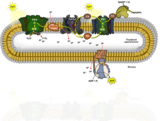
This illustration shows both the linear and cyclic flow of electrons during the light reaction of photosynthesis.
- Subject:
- Biology
- Botany
- Ecology
- Material Type:
- Diagram/Illustration
- Author:
- Eunice Laurent
- Date Added:
- 06/10/2022

This illustration shows both the linear and cyclic flow of electrons during the light reaction of photosynthesis.

Students learn about the basic principles of electromicrobiology—the study of microorganisms’ electrical properties—and the potential that these microorganisms may have as a next-generation source of sustainable energy. They are introduced to one such promising source: microbial fuel cells (MFCs). Using the metabolisms of microbes to generate electrical current, MFCs can harvest bioelectricity, or energy, from the processes of photosynthesis and cellular respiration. Students learn about the basics of MFCs and how they function as well as the chemical processes of photosynthesis and cellular respiration

This resource is a video abstract of a research paper created by Research Square on behalf of its authors. It provides a synopsis that's easy to understand, and can be used to introduce the topics it covers to students, researchers, and the general public. The video's transcript is also provided in full, with a portion provided below for preview:
"Cancers are complex diseases largely characterized by rapid cellular proliferation. This can be slowed by regulated cell death mechanisms like ferroptosis. Ferroptosis is triggered by extensive peroxidation of cell membrane phospholipids by reactive oxygen species (ROS), but ferroptosis can be inhibited by enzymes that undo peroxidation like GPX4. Another enzyme, DHODH, supports GPX4 and is vital to the production of pyrimidine nucleotides, critical building blocks for rapidly proliferating cells. In theory, this would make inhibiting DHODH a valuable therapeutic target for cancer by freeing up ferroptosis and hampering proliferation. However, this is complicated by the “Warburg effect,” which is common in some cancer cells. The Warburg effect is a shift away from using mitochondria for energy to other metabolic processes, which has knock-on effects..."
The rest of the transcript, along with a link to the research itself, is available on the resource itself.